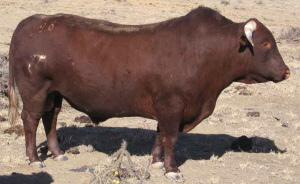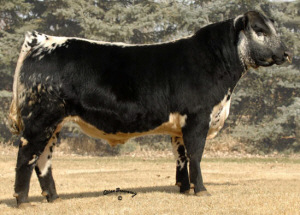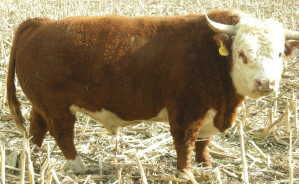



Barzona
History
The development of the Barzona began in 1942 by Francis Bard and his wife at their ranch in the intermountain desert area of Yavapai County, Arizona. They hoped to develop a breed that would be adapted to their area which was rugged and rocky, with extreme temperatures, sparse rainfall, and scattered feed. Bard said, "I want to find a breed or make a breed of cattle, that with the same number, on the same range, will produce more pounds of salable beef."
In 1946, E.S. "Jack" Humphrey joined with the Bard's and took over the management of the breeding operations. He combined the genetics of the Africander, Hereford, Angus and Santa Gertrudis.
Africander bulls were bred to Hereford cows, they wanted the Hereford for early maturity, good hindquarters, close sheath and range ability, Angus for carcass and marbling characteristics, small calf at birth followed by rich milk and good hind.
 Photo courtesy of Walking Stick Ranch, www.barzonacattle.com |
Santa Gertrudis bulls with "the Shorthorn factor," were also used because it was felt that three-eighths Brahma blood in the Santa Gertrudis was good from the standpoint of browse utilisation, hair and hide, small calf at birth and good milking ability. This basically completed the infusion of blood into the genetic pool and the Barzona breed was slowly developed by the studies with careful, planned matings to blend these different breeds and fix the desired characteristics. No outside blood was added to the herd after 1955.
Production records were maintained a rigid selection was carried out for fertility, rate of gain and mothering ability. Those animals with the most desirable records were used back in the breeding program. The best cattle in the developing breed were moved to Bard Kirkland Ranch in 1948, and in 1959 the entire operation was moved to that ranch.
By 1968, Barzona cattle were genetically recognised as an established breed, were well accepted by feeders and packers and the bulls were in demand by commercial ranchers for use in crossbreeding programs. As increasing numbers of cattlemen were becoming interested in having purebred herds, the need for a breed association was apparent.
In January 1968 the Barzona Breeders Association of America was formed in Phoenix. Bard passed away in January 1970 so Mrs Bard ran the ranch until 1973 when it became necessary to liquidate the ranch. The Bard-Kirkland ranch was sold and the entire foundation herd of Barzonas was dispersed. The cattle went to a few serious breeders who were dedicated to their continued development and improvement.
With Barzonas in the hands of these practical cattlemen, supported by a well organised and active association, the stage was set for this breed to go ahead and make a substantial contribution to the beef industry in America.
Characteristics
Modern Barzona are a medium size beef animal. Actual mature size varies somewhat with the environment. It is distinguishable by its longish head and may be either horned or polled. Barzona are generally medium red, but colour may vary from dark to light red, with occasional white on the underline or switch.
Barzonas possess a high degree of herd instinct and are curious and intelligent, but quiet and easy to handle. Barzona females tend to be fertile, breeding as yearlings to calve at two. With light birth weight, streamline shaped calves, they tend to calve easily without assistance and breed back year after year even under stressed conditions.
 Photo courtesy of Walking Stick Ranch, www.barzonacattle.com |
Statistics
Comparative
Distribution
Barzona cattle are produced in the USA.
References (the above information was cited from the following sites)
www.ansi.okstate.edu
www.barzona.com
www.barzonacattle.com


